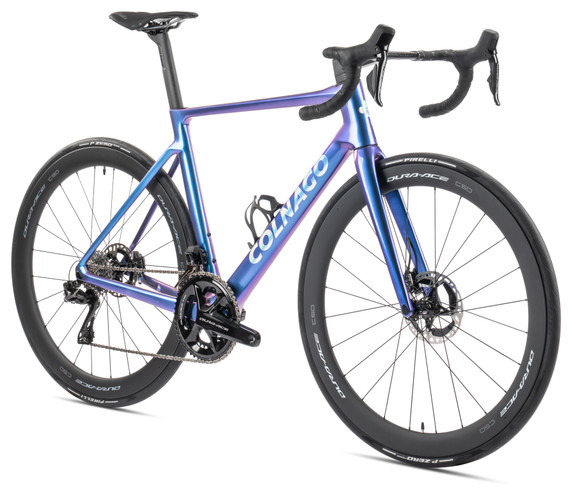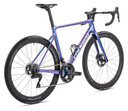V4RS IS BUILT TO WIN
The bicycle is an extremely complex system made up of many parts, subsystems and components, and the numerous required performances can trade off between each other. When supporting a top-level team there is no room to neglect any single aspect: in one racing season, or even in one race or stage, there are several conditions and situations in which the rider who wants to win must not accept compromises.
To develop a bicycle that performs the best in all racing conditions is a tough job, especially when the starting point is the V3Rs, a bike that is already a proven winner in all kinds of competitions: 2 Tour de France GC, Monument Classics (Liege, Lombardia), Classics (Strade Bianche and cobble-stone stages), sprint finishes, etc.
The only possible way to evolve without neglecting any detail is to work directly and constantly in contact with the best and most demanding riders in the world: from the initial design inputs to the final race validation, passing through all the development phases. The new Colnago V4Rs were built to do one thing: BUILT TO WIN.
The New CC.01
Colnago Cockpit CC.01 has a drag surface reduced by up to 16% compared to the cockpits mounted on V3Rs, and at the same time, the shape has been designed as a NACA-derived profile to have the minimum impact on the airflow, which is laminar and clean while impacting the components. This aerodynamic evolution was carried out without reducing the cockpit's overall stiffness, which is as important as aerodynamics in sprint and acceleration.
Aerodynamic Data
The performances of V4Rs are those of an aero bike. Compared to the V3Rs, in a real race setup (tested in the wind tunnel with an athlete pedalling at 50kph with 1 bottle and one empty bottle cage) we measured an aerodynamic saving of 3%, corresponding to approx. 13.2 watt. With an advanced aero setup (aero wheels and aero Colnago Computer support) the bike had an aerodynamic saving of 6% (approx. 27.7 watts saved)
Headtube Geometry
Its shape has been revised and perfectly integrated with the new lightweight fork (designed to allow an effective tire clearance up to 32mm) and with the new cockpit. Although the headset's upper bearings are bigger than those of the V3Rs, allowing the cables to run inside without the need for the D-shaped steerer column and enhancing the overall front-end stability, the overall shape has a better drag.
Stiffness
We created internal methodologies to replicate the loading forces of standing-on-pedals and seated positions and check the overall frame deformation and stiffness. We were able then to define what we call RDS (Real-Dynamic Stiffness), and characterize them in combined multi-load conditions.
Seated Position
In the seated position, loads are applied only on the same plane of the front triangle to replicate all-round riding: Taking the V3Rs as reference value, the V4Rs results as 5% stiffer in this occasion.
Sprint Position
In the sprint position there is a combination of loads applied both on the handlebar and the bottom bracket, with both components laying on the front triangle plane and normal to the frame plane, aimed to simulate the flexural and torsional stresses at oscillating cambers. Having the V3Rs as a reference value, the V4Rs results as 4% stiffer in this particular position.
Racing Feel
The new V4Rs significantly improve the crash worth of the most exposed parts which may be subjected to impact in racing conditions. An example is given by the completely newly designed seat stays, which, besides their more aerodynamic shape, also significantly improve the flexural and impact resistance. The robustness of this design also minimizes the need for maintenance.
Better Handing
The weight distribution has changed from the V3Rs. The front fork is now lighter and the overall weight of the frame kit and handlebar setup has been decreased by 56 grams. The result is better handling in corners and more safety and precision when going downhill.
Easier Bike Fitting
Geometry has been revised to have an even more balanced performance in all the different sizes concerning the V3Rs. For the V4Rs the relationship between seat tube length and reach is almost linear, the stack/reach ratio has been optimized and harmonized among all the sizes, and the chain stay length has been reduced. This geometry affords a better balance, power transfer and the same race feeling for all sizes.
Frame: Colnago V4RS
Thru-axle 12x142mm
Fork: Colnago V4RS Full Carbon Disc, thru-axle 12x100mm
Bottom Bracket: T47 Threadfit shell (Not Included in the Frame Kit)
Seatpost: Colnago V4RS Carbon Seatpost
| Price Match | Contact Us Here |
|---|---|
| Easy Returns | Info Here |
| Payment Options | Interest FREE Options Over $30 |
| Fast Shipping | Check Rates Here |
| Pushys ID | 167078 |
V4RS IS BUILT TO WIN
The bicycle is an extremely complex system made up of many parts, subsystems and components, and the numerous required performances can trade off between each other. When supporting a top-level team there is no room to neglect any single aspect: in one racing season, or even in one race or stage, there are several conditions and situations in which the rider who wants to win must not accept compromises.
To develop a bicycle that performs the best in all racing conditions is a tough job, especially when the starting point is the V3Rs, a bike that is already a proven winner in all kinds of competitions: 2 Tour de France GC, Monument Classics (Liege, Lombardia), Classics (Strade Bianche and cobble-stone stages), sprint finishes, etc.
The only possible way to evolve without neglecting any detail is to work directly and constantly in contact with the best and most demanding riders in the world: from the initial design inputs to the final race validation, passing through all the development phases. The new Colnago V4Rs were built to do one thing: BUILT TO WIN.
The New CC.01
Colnago Cockpit CC.01 has a drag surface reduced by up to 16% compared to the cockpits mounted on V3Rs, and at the same time, the shape has been designed as a NACA-derived profile to have the minimum impact on the airflow, which is laminar and clean while impacting the components. This aerodynamic evolution was carried out without reducing the cockpit's overall stiffness, which is as important as aerodynamics in sprint and acceleration.
Aerodynamic Data
The performances of V4Rs are those of an aero bike. Compared to the V3Rs, in a real race setup (tested in the wind tunnel with an athlete pedalling at 50kph with 1 bottle and one empty bottle cage) we measured an aerodynamic saving of 3%, corresponding to approx. 13.2 watt. With an advanced aero setup (aero wheels and aero Colnago Computer support) the bike had an aerodynamic saving of 6% (approx. 27.7 watts saved)
Headtube Geometry
Its shape has been revised and perfectly integrated with the new lightweight fork (designed to allow an effective tire clearance up to 32mm) and with the new cockpit. Although the headset's upper bearings are bigger than those of the V3Rs, allowing the cables to run inside without the need for the D-shaped steerer column and enhancing the overall front-end stability, the overall shape has a better drag.
Stiffness
We created internal methodologies to replicate the loading forces of standing-on-pedals and seated positions and check the overall frame deformation and stiffness. We were able then to define what we call RDS (Real-Dynamic Stiffness), and characterize them in combined multi-load conditions.
Seated Position
In the seated position, loads are applied only on the same plane of the front triangle to replicate all-round riding: Taking the V3Rs as reference value, the V4Rs results as 5% stiffer in this occasion.
Sprint Position
In the sprint position there is a combination of loads applied both on the handlebar and the bottom bracket, with both components laying on the front triangle plane and normal to the frame plane, aimed to simulate the flexural and torsional stresses at oscillating cambers. Having the V3Rs as a reference value, the V4Rs results as 4% stiffer in this particular position.
Racing Feel
The new V4Rs significantly improve the crash worth of the most exposed parts which may be subjected to impact in racing conditions. An example is given by the completely newly designed seat stays, which, besides their more aerodynamic shape, also significantly improve the flexural and impact resistance. The robustness of this design also minimizes the need for maintenance.
Better Handing
The weight distribution has changed from the V3Rs. The front fork is now lighter and the overall weight of the frame kit and handlebar setup has been decreased by 56 grams. The result is better handling in corners and more safety and precision when going downhill.
Easier Bike Fitting
Geometry has been revised to have an even more balanced performance in all the different sizes concerning the V3Rs. For the V4Rs the relationship between seat tube length and reach is almost linear, the stack/reach ratio has been optimized and harmonized among all the sizes, and the chain stay length has been reduced. This geometry affords a better balance, power transfer and the same race feeling for all sizes.
Frame: Colnago V4RS
Thru-axle 12x142mm
Fork: Colnago V4RS Full Carbon Disc, thru-axle 12x100mm
Bottom Bracket: T47 Threadfit shell (Not Included in the Frame Kit)
Seatpost: Colnago V4RS Carbon Seatpost








